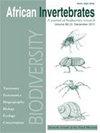Subfossil statoblasts of Lophopodella capensis (Sollas, 1908) (Bryozoa, Phylactolaemata, Lophopodidae) in the Upper Pleistocene and Holocene sediments of a montane wetland, Eastern Mau Forest, Kenya
IF 1.1
4区 农林科学
Q3 ENTOMOLOGY
引用次数: 7
Abstract
Lophopodella capensis (Sollas, 1908) is only known from a limited number of palustrine and lacustrine sites in southern Africa and single sites in both Kenya and Israel. Statoblasts of L. capensis were found preserved in the Upper Pleistocene and Holocene aged sediments of Enapuiyapui wetland, Eastern Mau Forest, western Kenya. he wetland is a headwater microcatchment of tributaries that feed into the Mara River and the Lake Victoria Basin. Bryozoan taxa were not surveyed in a 2007 macroinvertebrate biodiversity assessment. he presence of L. capensis at this site marks the second observation of this taxon in Kenya, 65 km from Lake Naivasha, where observed prior, and in a location some 1000 meters higher. he results suggest Bryozoa should be included in aquatic biodiversity surveys that target these wetlands and that bryozoan remains should be incorporated into palaeoecological studies as useful palaeoenvironmental indicators.肯尼亚东茂森林山地湿地上更新世和全新世沉积物中Lophopodella capensis (Sollas, 1908)(苔藓虫目,Phylactolaemata, lophopoddidae)的亚化石statoblasts
Lophopodella capensis (Sollas, 1908)仅在南部非洲数量有限的湖泊和湖泊遗址以及肯尼亚和以色列的单个遗址中被发现。在肯尼亚西部东部茂森林的Enapuiyapui湿地的上更新世和全新世沉积层中发现了L. capensis的Statoblasts。湿地是支流的源头微集水区,流入马拉河和维多利亚湖盆地。2007年大型无脊椎动物生物多样性评估中未对苔藓虫分类群进行调查。L. capensis在这一地点的出现标志着该分类群在肯尼亚的第二次观测,距离奈瓦沙湖65公里,海拔约1000米。研究结果表明,苔藓虫应纳入针对这些湿地的水生生物多样性调查,苔藓虫遗骸应作为有用的古环境指标纳入古生态研究。
本文章由计算机程序翻译,如有差异,请以英文原文为准。
求助全文
约1分钟内获得全文
求助全文
来源期刊

African Invertebrates
生物-动物学
CiteScore
1.00
自引率
0.00%
发文量
6
审稿时长
>12 weeks
期刊介绍:
African Invertebrates is an international peer-reviewed, open-access journal that focuses primarily on the taxonomy, systematics, biogeography, and palaeontology of Afrotropical invertebrates, whether terrestrial, freshwater or marine. Aspects concerning biology, ecology, and conservation may also be considered where these relate to the primary focus areas. Papers dealing solely with biology, ecology, physiology, pests and pest control should be submitted elsewhere.
 求助内容:
求助内容: 应助结果提醒方式:
应助结果提醒方式:


